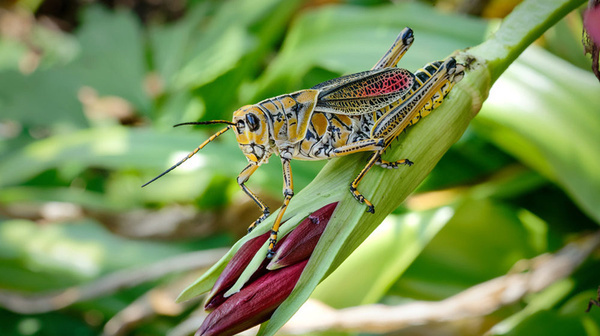
Grasshoppers, Fire Ants, and You
Unwelcome pests like the eastern lubber grasshopper and the red imported fire ant can be harmful, destructive, or just plain irritating. Reducing or eliminating them takes intentionality, so read on to take the first step toward effective pest management on your property.
Every place has a variety of insects; some promote plant growth and some cause damage. Here in Florida, pests include the eastern lubber grasshopper and red imported fire ant. Let’s go over what they are, where they show up, and how to manage or eradicate them.
Eastern Lubber Grasshoppers
What They Are
These distinctive pests are defoliators with two especially destructive traits:
First, they aren’t overly picky—they’ll feast on over 100 plant species. The lubber grasshopper will often munch through one leaf and move on to the next, leaving irregular holes behind. However, when their voracious appetite takes over, this pest can devour all the leaf tissue on a plant.
Second, the destruction caused by one grasshopper is nothing compared to what they can do in numbers. They can devastate entire gardens and crops.
Where They Occur
Look for tawny or yellow adults accented with black to identify the eastern lubber grasshopper, but know there is considerable color variation within the species. Found all over the southeast, they are present almost year-round in South Florida. In northern portions of the state, these pests are typically active from March to November.
How to Manage Them
The most effective management method is physically finding and capturing individual grasshoppers. This becomes more difficult as the population increases, but it’s the best place to start.
If that’s not doing the trick, spray an appropriate insecticide before the lubber grasshoppers mature and develop resistance to the chemicals.
Rife with RIFA
What They Are
The red imported fire ant (RIFA) is a colonizing insect that causes agricultural damage and harm to people and animals.
Because fire ants are omnivorous, they are not discriminating in what they eat. In some areas, entire ground-nesting bird species have been eliminated by the ants. Crops are impacted when ants feed on young plants and drastically reduce the amount that can be harvested. Finally, stings can cause human reactions ranging from minor irritation to anaphylactic shock.
Where They Occur
These ants are native to South America but have been introduced worldwide, including New Zealand, China, and the British Virgin Islands.
Most homeowners are very familiar with fire ants, which can be identified by their red or brown coloring, a “waist” with two segments, and four teeth on the “jaws.” The RIFA can be found throughout Florida and in many other U.S. states.
How to Manage Them
Fire ants are difficult to control and even harder to eliminate. But don’t worry, the Institute of Food and Agricultural Studies at the University of Florida has some recommendations.
- Bait: for use on individual mounds or to manage surrounding areas as well. Use carefully, as “broadcast” treatment can kill off native ant species as well.
- Pesticides: begin treatment with the least toxic pesticides and escalate only as necessary. Common treatment chemicals include hydramethylnon, avermectin, and fenoxycarb.
- Physical treatments: 3 gallons or more of boiling water poured onto a mound sometimes kills the queen and subsequently the entire colony. You can also dig up the mound and remove it.